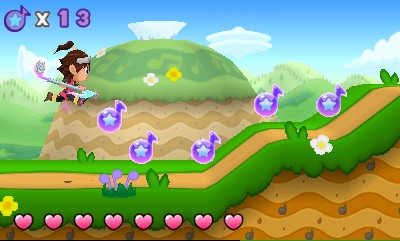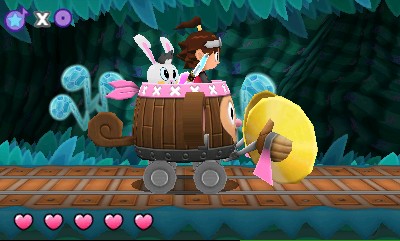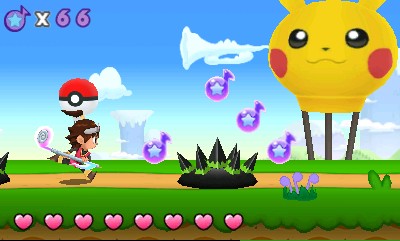Rhythm games may be an uncommon breed, but thankfully there are developers who keep the dream alive through reworking traditional means of player interaction with music. HarmoKnight, Game Freak's latest non-Pokemon endeavor, is one example, eschewing licensed top-40 tunes for light orchestral arrangements and cheery colors in a world where every beat counts. This lighthearted adventure's friendliness is initially refreshing, but the delights are worn down by HarmoKnight's simplicity and repetitiveness.
Tempo is your avatar in HarmoKnight, and he's more of a carefree child than a revered hero. Though he has been diligently training under former esteemed Royal Guard Woodwin, he's still very much an amateur. But when the world of Melodia comes under attack, Tempo must be quick to defend the land and its royalty from the tyrannical Noizoids, who wish to take over in typical evil monster fashion. Alongside Tappy, the rabbit who provides helpful guidance, and new friends he meets on the journey through Melodia, Tempo harnesses the power of rhythm to conquer the forces of evil.
If it sounds like a tale pulled straight from the pages of RPG Heroes 101, that's because that's what it is. It's an endearing, family-friendly tale of kindness and working together supported by bits and pieces of traditional rhythm game and platformer conventions. These characters are bland, quite obviously born as simple avatars meant to thread the simple story together. The real meat of the game, as with the rest in the genre, is the music and how you interact with it.
Each level is a bite-size candy crunch, with Tempo usually running through a basic horizontal scrolling map rife with enemies and traps. Timing jumps and swats with the magical staff to go with the accompanying tracks unique to the level nets you more notes, which determine your overall performance ranking. Some levels feature branching paths, where you're encouraged to take a specific route. Tappy will point these out, warning you to aim for a higher or lower path to avoid dangerous traps and more difficult obstacles. By following his instructions you’ll earn more notes and save yourself a possible restart. You can choose to take the harder paths, but there’s no real reward for doing so, save for bragging rights.
Basic mechanics can be frustrating enough in some areas that an easier path should always be your first choice. A hit or a jump right on the beat might net you an "okay" result or a halfhearted attack without the accompanying "great" tone. When the musical accompaniments meant for each level aren't particularly memorable in the first place, it can be tough to get a feel for the right pacing or how the change in speed or an alteration to a downbeat affects your timing. And even when you feel as though you're completely in step, sometimes the game simply rebels against you, despite the fact that you can still breeze through with less-than-perfect rhythm.
The rhythmic inconsistency isn't as much of an issue in HarmoKnight's basic scrolling levels, but it can present a problem when you're confronting the high-speed mine cart levels or boss encounters. These sequences play out in a classic call-and-response pattern, where Tempo must zigzag around craggy mountains or snowy hilltops while avoiding three to five waves of enemy attacks. The instructions are clear--"left, right, left, left, hit!"--and you parrot the movements to dodge and defend yourself. You could follow the aural instructions and time them with visual cues as well, but the audio indicator that signals Tempo's turn is not always in sync, making it easier to close your eyes and complete the responses so as not to be thrown off by visuals that aren't in time with the music in some areas. These sections are not major missteps, but they needed tighter execution, more varied musical selections, and improved visual cues.
You sometimes need to switch to one of Tempo's friends to overcome certain challenges. This is an attempt at adding another layer of intricacy to what quickly devolves into bland hop-swing-bounce segments interspersed with miniature boss encounters and cart rides. Lyra is equipped with long-range attacks, which are used in the same manner as Tempo's staff, though her reticle changes, and the enemies she fells are usually at a distance. Tyko and his pet monkey are good for brute strength, either for high or low targets. But they never feel necessary, and it's Tappy who tags Lyra and Tyko in, so to speak, bringing the music and the action to a screeching halt should upcoming level segments require talents other than Tempo's. This jarring break in rhythm is a frustration that could have been avoided entirely by keeping substitutions in time with the music or omitting them entirely, leaving Lyra and Tyko as optional playable characters instead of requiring them mid-level.
You need to collect royal notes earned from performing well in each level. They are extremely simple to obtain, since even subpar performances net you at the very least a silver ranking, which is good for one royal note. You must collect a specific number of royal notes to progress, so if you're finding it difficult to keep up, you may be in for a bit of backtracking. The game can be completed in a couple of hours. While you can go back and speed up each area for a quicker playthrough, the eighth world unlocked after completing the first seven is a better use of your time, as it provides a somewhat heartier challenge. Additionally, there are some bonus Pokemon stages dotted with Poke Ball decorations, which is an unexpected treat.
The cheery aesthetic is uplifting enough, with eye-popping color palettes and cartoonish character designs. It's dazzling for the eyes, especially when viewed in 3D, and it harks back to a time when fantasy ruled and simplicity was key. HarmoKnight is a darling rhythm platformer with plenty of heart, but it's over too quickly, offering little in the way of surprises or challenge, and providing too scant a challenge to inspire return visits. Game Freak has a lot up its sleeve, but as is, its maiden voyage into the rhythm genre isn't an entirely successful one.
'

